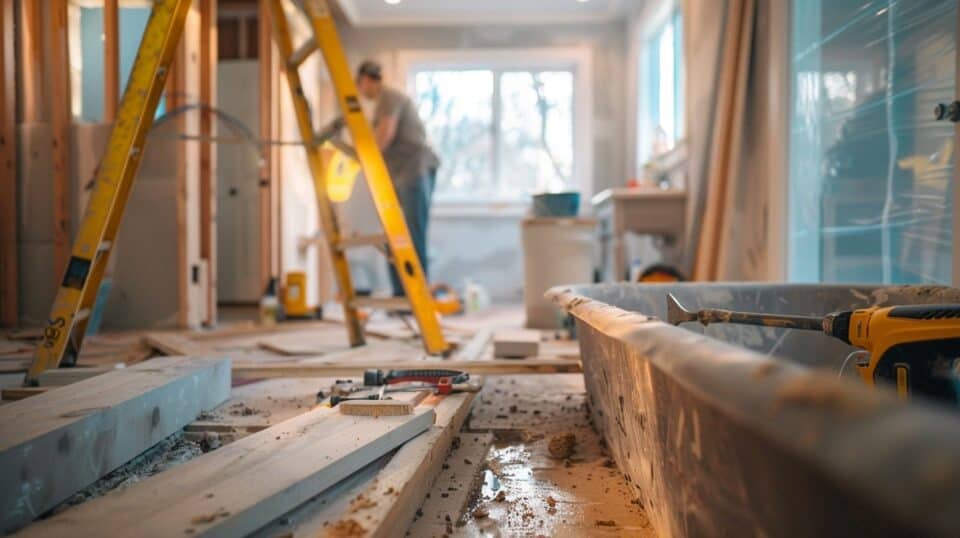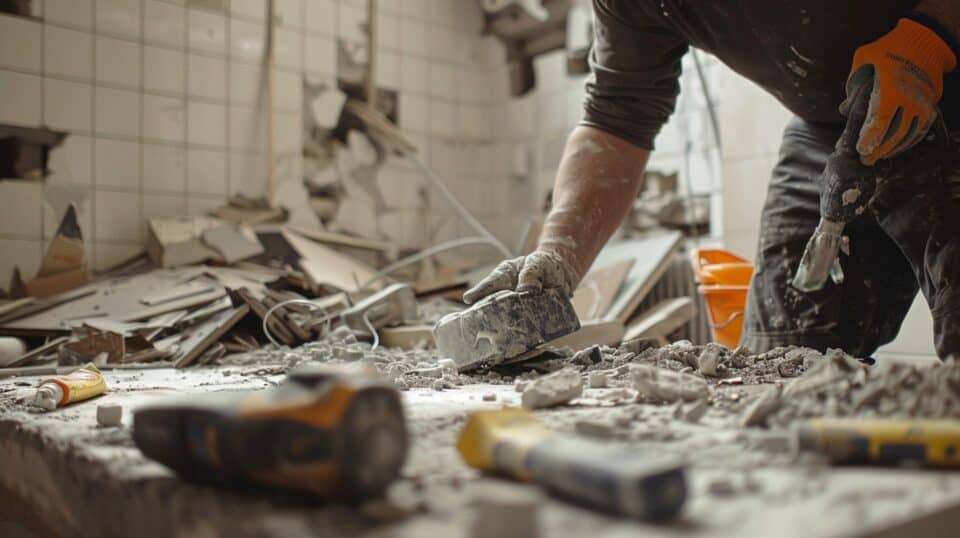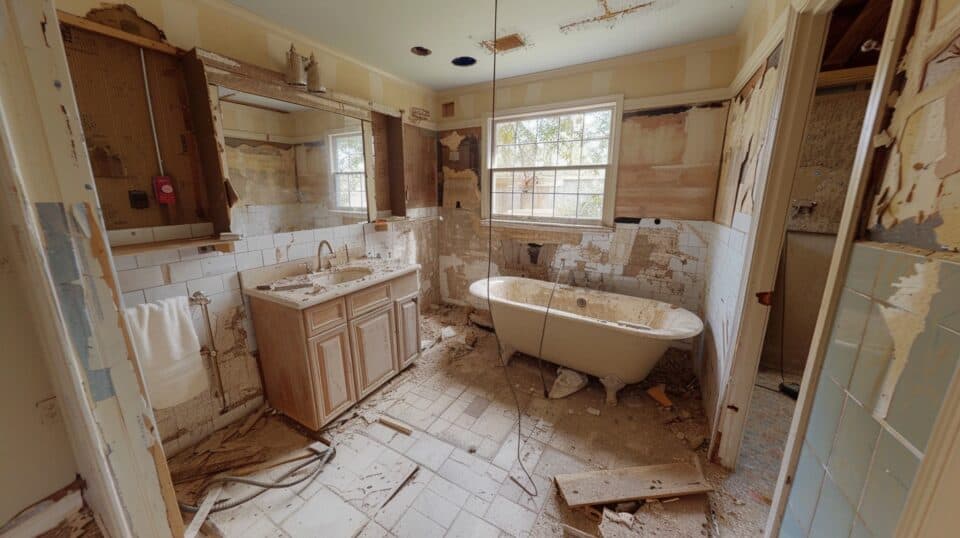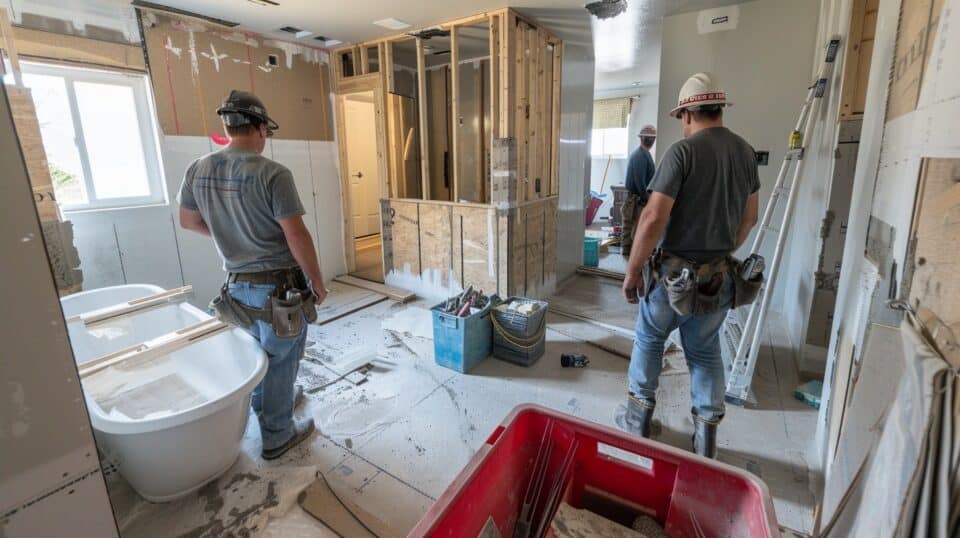Deciding how long a bathroom remodel should take can be tricky. On average, it spans 3 to 6 weeks. This blog will detail the steps and offer tips to complete your project efficiently.
Keep reading for expert advice…
Key Takeaways
A bathroom remodel can take between 3 and 6 weeks. This time includes planning, getting permits, construction, and finishing touches.
Planning ahead is key. Get your permits early, choose skilled contractors and buy all materials before starting.
Unexpected issues often cause delays. Set aside extra time in your plan for surprises.
Hiring a professional team saves time and ensures high-quality work compared to doing it yourself.
Keep organized with a detailed timeline and communicate well with your team to make the project go smoother.
Table of Contents
Key Phases of a Bathroom Remodel

A bathroom makeover goes through a few main steps: getting ready, building, and finishing up. First, you plan by picking teams and buying stuff; then the real work starts with tearing down and putting up new parts like showers and sinks; finally, you check everything to make sure it’s right.
Preparing for Construction
First, you must get permits. This process takes 4–6 weeks. You post the job and schedule site visits to choose your contractors during this time. Next, pick a general contractor who knows about renovations—especially bathrooms.
They should understand tile work, plumbing for showers and sinks, and fitting wood bathroom vanities with tops.
Then, gather all materials needed for demolition and remodeling like tiles for walls and floors, shower heads, and joint compound for ceilings. Make sure everything is ready before construction starts to avoid delays.
This step ensures your bathroom remodel goes smoothly from start to finish without unnecessary stops.
Active Construction Phase
The crew tears out old fixtures first, making room for new ones. This process takes 1–2 days. Next comes the plumbing rough-in, requiring a skilled plumber to update pipes and install new fixtures.
They finish this in about 2 days. Laying down tiles is next—this step transforms the space’s look but needs careful attention, taking up to 7 days or more depending on the design’s complexity.
Then, they focus on electrical systems to ensure safe wiring for lights and fans—a critical step involving both general contractors and electricians. Flooring goes in last after drywall; it only takes 1–2 days but makes a huge difference in how the bathroom feels underfoot.
Throughout these steps, teamwork between different experts ensures that each task flows smoothly into the next without delays or mishaps.
Wrapping Up the Project
In the final stretch, contractors perform a detailed walkthrough and conduct the last inspection. All parts of the job must pass this review. This step is crucial. It ensures everything was done right, from plumbing to plating.
After this, it’s time to finish up accounts and payments. Make sure all services are paid for and squared away.
Always measure twice and cut once in remodeling.
Reserve 1.5 days for any unexpected issues or delays that might pop up, even during these last stages. This buffer allows fixing any minor problems without rushing. Completing a project smoothly means checking off each task with care and precision—hooking up fixtures like sinks takes 1–2 days, but is an essential part of wrapping things up properly.
Steps in Pre-Construction

Before anything else starts, getting ready is key. You need to get permits and pick the right team for the job—think of it as laying down the groundwork. Making sure you have all your supplies lines up means no waiting later on.
This phase sets everything in motion so that the rest can follow smoothly.
Securing Necessary Permits
Securing necessary permits is a crucial first step. It ensures your bathroom remodel meets all local building codes. Getting these permits can take 4–6 weeks. You need to apply early to avoid delays.
Visit your city’s planning office or their website for details on how to apply. Make sure you have a clear plan of what the remodel involves. This helps speed up the process.
After securing permits, choosing the right contractors is next. They will bring your bathroom vision to life while following all rules and regulations.
Selecting the Right Contractors
Once the permits are in hand, finding skilled contractors is next. The choice of a general contracting team does wonders for your bathroom remodel. This step matters because hiring multiple teams can mess up the schedule.
It’s best to go with experts who have done this before.
Look for a team with good reviews and finished projects you like. They’ll handle everything from demolition to final inspection. A solid contractor also keeps delays low and ensures that all parts, like plumbing and electrical work, fit together perfectly.
This way, your project moves smoothly to completion without unexpected hiccups or costs.
Acquiring Materials
Getting all the materials ready is a big step. You need tiles, paint, and fixtures. Buying from local stores helps our community. It also makes sure you get what you need faster. Make a list of everything before you go shopping.
Use a concrete roadmap to avoid backtracking.
Plan your visits to stores or websites that have good reviews. Check their stock online first to save time. This way, you ensure everything for your project arrives on time, without delays.
Detailed Construction Timeline

Understanding the timeline for your bathroom makeover is key. It guides you through tearing out old pieces, fixing water pipes and wires, and putting up walls, floor coverings, and color.
This step makes sure your project moves smoothly. Explore more to see how each part fits into the puzzle of a quick remodel.
Removing Old Fixtures
Taking out old fixtures marks the first real step in your bathroom remodel, lasting about 1–2 days. This step is all about clearing space—think tubs, sinks, toilets, and cabinets have to go.
Every piece gets removed so that updates can start fresh. Workers use tools like sledgehammers and crowbars to do this job safely and quickly.
Next comes updating plumbing and electrical systems…
Updating Plumbing and Electrical Systems
Plumbing and electrical updates need a careful hand. For plumbing, it takes two days to adjust pipes and fittings for water and waste. Electricians spend one day wiring new lights and outlets.
These tasks must happen before walls close up with drywall, ensuring everything works right.
Upgrading these systems makes your bathroom safe and modern.
To do this, experts use tools like pipe wrenches and wire strippers. They follow codes to make sure all changes are correct. With skilled professionals, the job goes smoothly, avoiding delays in your remodel project.
Installing Drywall, Tiles, and Paint
After the plumbing and electrical systems are updated, it’s time to focus on walls and floors. We hang drywall in just one day. It prepares the room for tiles and paint. Next comes tile work, which is a longer task.
Taking seven days or more, we lay down each piece carefully to ensure everything aligns perfectly and looks great. This step transforms the bathroom’s appearance.
Painting takes another day. Choosing the right color can make the space feel bigger or cozier, depending on what you want. I always recommend high-quality paint that handles moisture well for bathrooms.
This way, your new-look stays fresh longer.
Final Steps in Post-Construction

After all the work is done, it’s time for a careful check and to make sure everything is paid for. A professional will come to see if all parts are right and safe, then you’ll go over everything with the people who did the job to ensure no detail is missed.
Conducting Final Inspections
Final inspections happen fast, taking just one day. Inspectors check the bathroom for safety issues. They look at everything to make sure it’s safe and follows rules.
Safety is not expensive, it’s priceless.
This step is crucial to ensure your new bathroom meets all safety standards. It secures peace of mind that everything was done right.
Completing Contractor Walkthroughs
After all work is done, it’s time for contractor walkthroughs. This step makes sure everything meets your standards. You and the contractor will look at every part of your new bathroom together.
If something isn’t right or needs more work, now is the time to spot it. This ensures changes happen until you are happy with the results.
This process involves checking plumbing, paint, tiles, and other details closely. You need to point out any issues you see so they can fix them fast. This final check helps avoid future problems and guarantees you love your new space.
Settling Accounts and Payments
Paying the contractor on time is key. Make sure you have the full amount ready by the end of the project. Being quick and responsive helps too. If questions or issues pop up, solving them fast keeps everything moving smoothly.
This way, both sides are happy – you get your finished bathroom without delays, and they get paid for their hard work.
Next comes dealing with any final inspections to ensure everything is up to code.
Factors Influencing Remodel Duration

Lots of things can change how long it takes to redo a bathroom. The old bathroom’s shape, if you do the work or hire someone, and getting all the stuff you need to play big roles.
Condition of the Existing Bathroom
The bathroom’s age and wear greatly impact the remodel time. Old pipes, worn-out tiles, and outdated fixtures add days to the project. You inspect and find broken pipes hiding behind walls or mold under old flooring.
These issues demand immediate fixing before new installations begin.
Replacing everything from plumbing to lighting ensures a smooth remodel.
Materials vary in longevity; for example, ceramic tiles outlast vinyl ones. This affects decisions on what to replace versus repair. Every choice directly changes how long the work takes.
Quick fixes might seem faster but could lead to more work later if not done properly from the start.
Differences Between Professional and DIY Efforts
Understanding the differences between professional and DIY efforts in bathroom remodeling is crucial. Here’s a concise comparison:
| Aspect | Professional | DIY |
|---|---|---|
| Time Management | Efficient, with a defined timeline. | Varies greatly based on personal schedule and skill level. |
| Quality of Work | High, due to experience and access to professional tools. | Depends on individual skill, can be inconsistent. |
| Cost | Higher upfront, but includes labor and expertise. | Lower initial costs, but may require fixes later. |
| Risk Management | Handled by professionals; insurance covers accidents. | Personal risk; mistakes can be costly. |
| Scheduling Contractors | Managed by the professional team, streamlined. | N/A – not applicable for DIY. |
| Access to Materials | Direct access to wholesale, professional-grade materials. | Limited to retail, often at higher prices. |
From personal experience, hiring professionals can save time and ensure a high-quality finish, despite the higher initial cost. DIY projects offer personal satisfaction and can be cost-effective but come with risks and potential for time delays. Opting for professional help or undertaking a DIY project depends on personal priorities, skills, and budget.
Availability of Required Materials
Getting all the materials ready can slow things down. If you pick local shops for tiles and paint, it helps our community too. Sometimes stores don’t have everything when you need them.
This happened to me. I had to wait extra weeks for special fixtures to come in. So, plan ahead and order early.
Local options often have what’s popular here, but might not carry rare items or specific brands that make your bathroom unique. Make a list of everything needed before starting—taps, light fixtures, vanity units—and check availability at several places.
It saves time later and avoids last-minute rushes that delay work.
Tips to Speed Up a Bathroom Remodel

To make your bathroom fix-up faster, plan well, pick skilled workers, and tackle surprises smartly. Check out more ideas to get done quicker.
Organizing and Scheduling Efficiently
To make your bathroom remodel move smoothly, plan every step ahead. This means setting clear dates for when each part of the job will start and finish. For example, securing permits might take one to two weeks.
Always allow extra time in your schedule for these steps. I found that adding a week or two beyond what you think is necessary helps manage delays without stress.
Use a calendar to track progress and set reminders for important tasks like ordering materials early on. Materials can be tiles, sinks, or lights — whatever your new bathroom needs.
I always order these items as soon as my plan is firm. This way, if something is out of stock, there’s time to pick something else without holding up the work crew later on. Keep close contact with your contractors too; letting them know the timeline keeps everyone focused and avoids waiting periods where nothing gets done because someone wasn’t ready or available.
Hiring Competent Contractors
After planning your schedule, picking the right team is crucial. Good contractors make work smooth and keep delays away. They know how to handle surprises without messing up the timeline.
Picking one skilled group, instead of many, helps avoid scheduling nightmares. Look for teams with lots of experience in bathroom remodels. Their past jobs show if they’re good or not.
Choosing experts speeds things up because they already know what needs to be done and how to tackle tough spots without wasting time or materials. Make sure they have a clear record of finishing jobs on time and within budget.
This step ensures your project stays on track from start to finish.
Managing Unforeseen Challenges
To manage surprises, always plan for extra time. My past projects taught me this. We set aside 1.5 days for unexpected issues, like finding old pipes that need replacing or drywall damage behind the old tiles.
This buffer keeps the remodel on track without rushing contractors to finish.
Quick decision-making helps too. Once, hidden water damage slowed us down. But we quickly chose new materials and adjusted our plans. This kept delays short and costs under control.
Always have a backup option ready and stay flexible with your schedule to handle any challenge smoothly.
People Also Ask
How long does a typical bathroom remodel take?
A basic bathroom remodel can take about 2 to 3 weeks, depending on what you’re doing.
Will adding more workers make my bathroom remodel faster?
Yes, but there’s a limit; too many people in a small space can slow things down.
Can I use my bathroom during the remodel?
Nope, not if it’s a full remodel. Plan for an alternative, like using another bathroom in your house.
Does the size of my bathroom affect how long the remodel will take?
Sure does! Larger bathrooms often take longer to finish than smaller ones.
What’s the quickest part of a bathroom remodel?
Painting and installing new fixtures are usually the fastest tasks, done towards the end of the project.


